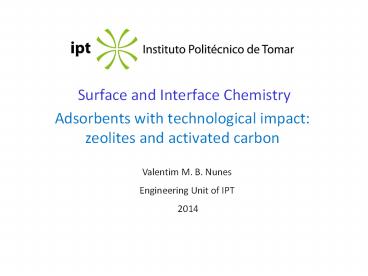Surface and Interface Chemistry - PowerPoint PPT Presentation
Title:
Surface and Interface Chemistry
Description:
Surface and Interface Chemistry Adsorbents with technological impact: zeolites and activated carbon Valentim M. B. Nunes Engineering Unit of IPT – PowerPoint PPT presentation
Number of Views:135
Avg rating:3.0/5.0
Title: Surface and Interface Chemistry
1
- Surface and Interface Chemistry
- Adsorbents with technological impact zeolites
and activated carbon
Valentim M. B. Nunes Engineering Unit of IPT 2014
2
Throughout the course were explored classical
areas of chemistry of surfaces and Interfaces,
with some detail (in some cases) and
comprehensiveness.
In this lesson, we will deepen a subject
discussed earlier, solid surfaces, focusing the
study on two kinds of materials with large
industrial application zeolites and activated
carbon.
3
Drying, purification and separation of gases and
hydrocarbons
adsorbents
zeolites
Ionic Exchangers
Catalysts in refining processes heterogeneous
catalysis
4
The origin of the term zeolite was due to the
chemist and mineralogist Axel Fredrik Cronstedt
and derives from the Greek words "zein" (boil)
and "lithos" (stone).
- From 1954 synthetic zeolites began to be used as
molecular sieves in industrial processes of
separation and purification of gases - The most important use (heterogeneous Catalysis)
began in 1962 catalytic cracking.
5
A zeolite is a crystalline aluminosilicate
(mineral or synthetic) with micro porous
structure and well defined cavities occupied by
ions and molecules of H2O with freedom of
movement for exchange with other ions and
reversible dehydration.
General formula Mz(AlO2)x(SiO2)y.wH2O
6
Structure
Zeolites have a three-dimensional structure with
a porosity of regular dimensions comparable to
those of organic molecules, and with pore
openings ranging from about 3 to 10 Å. They
contain SiO4 and AlO4 units linked by oxygen.
The zeolite of type A contains equal amounts of
silicon and aluminum. The pores are formed by
rings of 4, 6 and 8 oxygen atoms, being the
largest pore dimension equal to 4.1 Å
7
(No Transcript)
8
(No Transcript)
9
Synthesis (example)
10
Industrial applications adsorption
Molecular Sieves. Capillary condensation as a
result of small dimensions of surface, increasing
the adsorbed concentration. Selectivity
adsorption due to existence of charges (Polar
molecules)
Example gas drying!
11
(No Transcript)
12
Industrial application ionic exchangers
Application in great expansion, is the use of
zeolites as adjuncts in household detergents, for
removal of cations, such as calcium and
magnesium, to reduce the water hardness.
Ammonia removal from municipal sewage
13
Industrial application catalysis
Selectivity of molecules by geometric motifs, and
kinetic effects related to diffusion. High
specific area or BET area. Example Catalytic
Cracking to obtain petrol with C5 C6 with high
octane index.
14
In petrochemical processing, zeolites are used as
catalysts for Fluid Catalytic Cracking (FCC
process), a process which transforms long-chain
alkanes (heavy oil) into shorter ones (petrol),
to enhance the octane number of the petrol by
producing branched species.
15
http//www.iza-online.org/
16
Activated carbon is a material with high
porosity. With the use of nitrogen adsorption
techniques at 77 K, it can be verified that it
contains essentially micro pores. Activated
carbon has the ability to selectively collect
gases, liquids or impurities inside the pores,
showing a great ability for clarification,
deodorizing and purification of liquids or gases
(wastewater treatment).
17
(No Transcript)
18
Drug detox treatment
Water treatment purification of public supply
water
Industrial water recycling removal of substances
present in the water, as for example,
naphthalene's, benzene, phenol, benzene and
sulfonates.
Activated carbon
Food industry adsorption of molecules that cause
taste, color or undesirable odor.
19
Activated carbon is characterized by the high
specific area (m2/g) 600 to 1600 m2/g, withe
typical values in the range of 900 m2/g.
However, the activity of coal is associated to
internal pores and fissures specific surface has
little influence on the total capacity of the
activated carbon.
20
Activated carbon (AC) filters have been used in
home water purification systems primarily to
remove taste and odor
21
(No Transcript)
22
(No Transcript)
23
(No Transcript)
24
Adsorption isotherms
25
(No Transcript)

